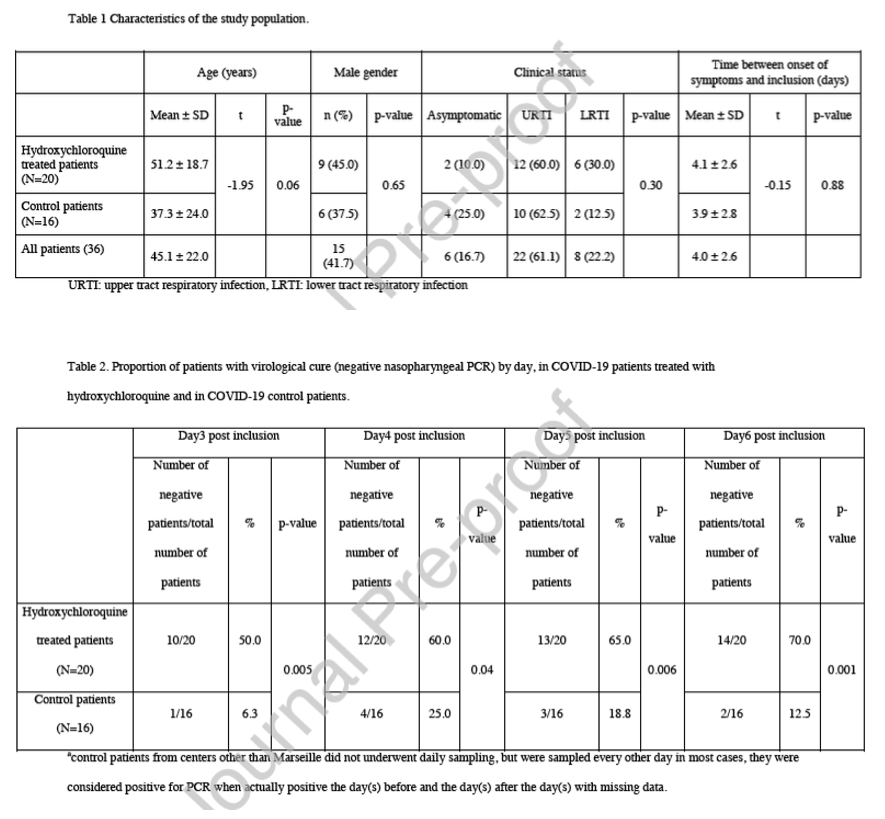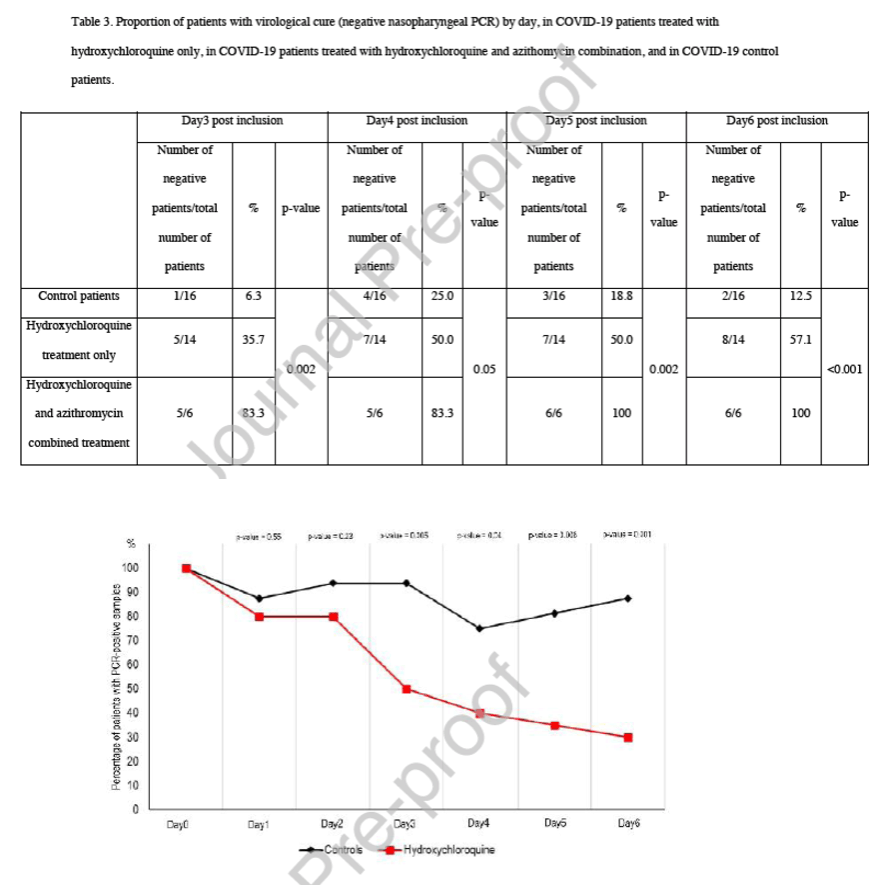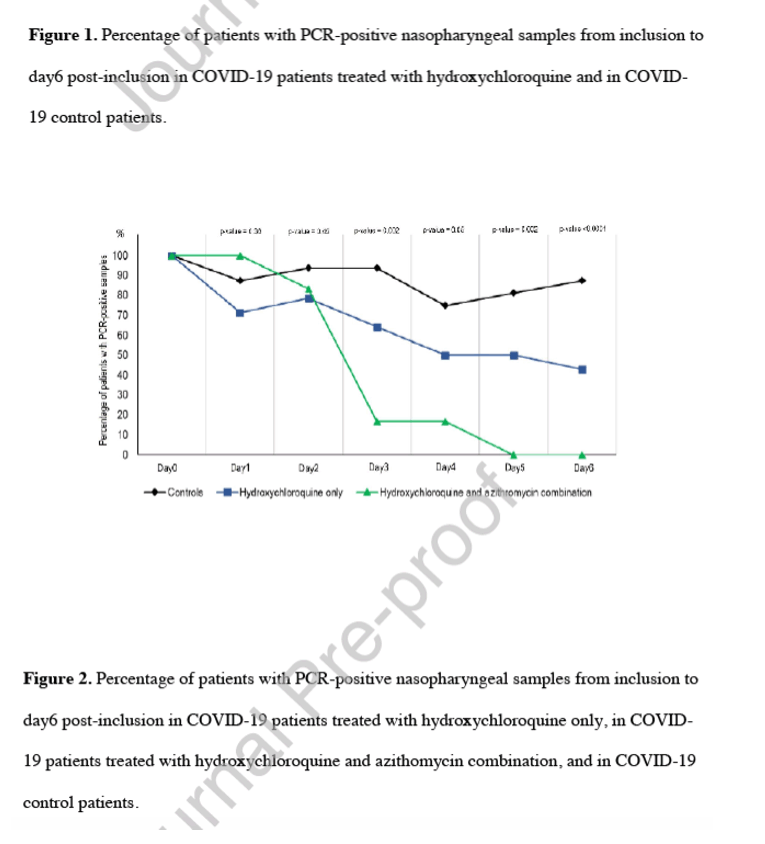| |
Hydroxychloroquine and azithromycin as a treatment
of COVID-19: results of an open-label non-randomized clinical trial
|
| |
| |
Download the PDF here
https://www.sciencedirect.com/science/article/pii/S0924857920300996
Our preliminary results also suggest a synergistic effect of the combination of hydroxychloroquine and azithromycin.....Azithromycin has been shown to be active in vitro against Zika and Ebola viruses [20-22] and to prevent severe respiratory tract infections when administrated to patients suffering viral infection [23].
This finding should be further explored to know whether a combination is more effective especially in severe cases.
Speculated potential risk of severe QT prolongation induced by the association of the two drugs has not been established yet but should be considered.
Further studies on this combination are needed, since such combination may both act as an antiviral therapy against SARS-CoV-2 and prevent bacterial super-infections.
Further works are also warranted to determine if these compounds could be useful as chemoprophylaxis to prevent the transmission of the virus, especially for healthcare workers.
Our study has some limitations including a small sample size, limited long-term outcome follow-up, and dropout of six patients from the study, however in the current context, we believe that our results should be shared with the scientific community.
---------------------------
In some people, Plaquenil can cause a condition called hydroxychloroquine retinopathy, often referred to as bulls-eye maculopathy. ... As the disease progresses, it begins to affect central vision and becomes life-altering. The changes are most often permanent, but in some cases, vision has improved.Oct 21, 2019.....In some people, Plaquenil can cause a condition called hydroxychloroquine retinopathy, often referred to as bulls-eye maculopathy. (The condition sometimes resembles a target, or bulls-eye ring, on the retina surrounding the macula.) Hydroxychloroquine retinopathy is extremely rare and is most often seen in cases where the dosage is high or the patient has been taking it for several years. Bulls-eye maculopathy is uncommon, but when it does occur, it can be devastating visually.
As the disease progresses, it begins to affect central vision and becomes life-altering. The changes are most often permanent, but in some cases, vision has improved. Most rheumatologists recommend patients undergo a baseline eye examination prior to starting Plaquenil and be re-examined in the future depending on their risk for developing the condition. Risk factors include advanced age and having pre-existing retinal disease.
https://www.verywellhealth.com/plaquenil-and-your-eyes-3421852
-----------------------------
In this report we describe our early results, focusing on virological data in patients receiving hydroxychloroquine as compared to a control group.....At day6 post-inclusion, 100% of patients treated with hydroxychloroquine and azithromycin combination were virologicaly cured comparing with 57.1% in patients treated with hydroxychloroquine only, and 12.5% in the control group (p<0.001). These results are summarized in Figures 1 and 2. Drug effect was significantly higher in patients with symptoms of URTI and LRTI, as compared to asymptomatic patients with p<0.05 (data not show). Of note, one patient who was still PCR-positive at day6-post inclusion under hydroxychloroquine treatment only, received azithromycin in addition to hydroxychloroquine at day8-post inclusion and cured her infection at day-9 post infection. In contrast, one of the patients under hydroxychloroquine and azithromycin combination who tested negative at day6 post-inclusion was tested positive at low titer at day8 post-inclusion.
---------------------------
Hydroxychloroquine and azithromycin as a treatment of COVID-19: results of an open-label non-randomized clinical trial
Abstract
Background
Chloroquine and hydroxychloroquine have been found to be efficient on SARS-CoV-2, and reported to be efficient in Chinese COV-19 patients. We evaluate the role of hydroxychloroquine on respiratory viral loads.
Patients and methods
French Confirmed COVID-19 patients were included in a single arm protocol from early March to March 16th, to receive 600mg of hydroxychloroquine daily and their viral load in nasopharyngeal swabs was tested daily in a hospital setting. Depending on their clinical presentation, azithromycin was added to the treatment. Untreated patients from another center and cases refusing the protocol were included as negative controls. Presence and absence of virus at Day6-post inclusion was considered the end point.
Results
Six patients were asymptomatic, 22 had upper respiratory tract infection symptoms and eight had lower respiratory tract infection symptoms.
Twenty cases were treated in this study and showed a significant reduction of the viral carriage at D6-post inclusion compared to controls, and much lower average carrying duration than reported of untreated patients in the literature. Azithromycin added to hydroxychloroquine was significantly more efficient for virus elimination.
Conclusion
Despite its small sample size our survey shows that hydroxychloroquine treatment is significantly associated with viral load reduction/disappearance in COVID-19 patients and its effect is reinforced by azithromycin.
Introduction
In late December 2019, an outbreak of an emerging disease (COVID-19) due to a novel coronavirus (named SARS-CoV-2 latter) started in Wuhan, China and rapidly spread in China and outside [1,2]. The WHO declared the epidemic of COVID-19 as a pandemic on March 12th 2020 [3]. According to a recent Chinese stud, about 80% of patients present with mild disease and the overall case-fatality rate is about 2.3% but reaches 8.0% in patients aged 70 to 79 years and 14.8% in those aged ≥80 years [4]. However, there is probably an important number of asymptomatic carriers in the population, and thus the mortality rate is probably overestimated. France is now facing the COVID-19 wave with more than 4500 cases, as of March 14th 2020 [5]. Thus, there is an urgent need for an effective treatment to treat symptomatic patients but also to decrease the duration of virus carriage in order to limit the transmission in the community. Among candidate drugs to treat COVID-19, repositioning of old drugs for use as antiviral treatment is an interesting strategy because knowledge on safety profile, side effects, posology and drug interactions are well known [6,7].
A recent paper reported an inhibitor effect of remdesivir (a new antiviral drug) and chloroquine (an old antimalarial drug) on the growth of SARS-CoV-2 in vitro, [8] and an early clinical trial conducted in COVID-19 Chinese patients, showed that chloroquine had a significant effect, both in terms of clinical outcome and viral clearance, when comparing to controls groups [9,10]. Chinese experts recommend that patients diagnosed as mild, moderate and severe cases of COVID-19 pneumonia and without contraindications to chloroquine, be treated with 500 mg chloroquine twice a day for ten days [11].
Hydroxychloroquine (an analogue of chloroquine) has been demonstrated to have an anti-SARS-CoV activity in vitro [12]. Hydroxychloroquine clinical safety profile is better than that of chloroquine (during long-term use) and allows higher daily dose [13] and has fewer concerns about drug-drug interactions [14]. Our team has a very comprehensive experience in successfully treating patients with chronic diseases due to intracellular bacteria (Q fever due to Coxiella burnetii and Whipple's disease due to Tropheryma whipplei) with long-term hydroxychloroquine treatment (600 mg/day for 12 to 18 months) since more than 20 years. [15,16] We therefore started to conduct a clinical trial aiming at assessing the effect of hydroxychloroquine on SARS-CoV-2-infected patients after approval by the French Ministry of Health. In this report we describe our early results, focusing on virological data in patients receiving hydroxychloroquine as compared to a control group.
Discussion
For ethical reasons and because our first results are so significant and evident we decide to share our findings with the medical community, given the urgent need for an effective drug against SARS-CoV-2 in the current pandemic context.
We show here that hydroxychloroquine is efficient in clearing viral nasopharyngeal carriage of SARS-CoV-2 in COVID-19 patients in only three to six days, in most patients. A significant difference was observed between hydroxychloroquine-treated patients and controls starting even on day3 post-inclusion. These results are of great importance because a recent paper has shown that the mean duration of viral shedding in patients suffering from COVID- 19 in China was 20 days (even 37 days for the longest duration) [19]
Very recently, a Chinese team published results of a study demonstrating that chloroquine and hydroxychloroquine inhibit SARS-CoV-2 in vitro with hydroxychloroquine (EC50=0.72%μM) found to be more potent than chloroquine (EC50=5.47%μM) [14]. These in vitro results corroborate our clinical results. The target values indicated in this paper [14] were reached in our experiments. The safer dose-dependent toxicity profile of
hydroxychloroquine in humans, compared to that of chloroquine [13] allows using clinical doses of hydroxychloroquine that will be over its EC50 observed in vitro [14].
Our preliminary results also suggest a synergistic effect of the combination of hydroxychloroquine and azithromycin. Azithromycin has been shown to be active in vitro against Zika and Ebola viruses [20-22] and to prevent severe respiratory tract infections when administrated to patients suffering viral infection [23]. This finding should be further explored to know whether a combination is more effective especially in severe cases. Speculated potential risk of severe QT prolongation induced by the association of the two drugs has not been established yet but should be considered. As for each treatment, the cost benefits of the risk should be evaluated individually. Further studies on this combination are needed, since such combination may both act as an antiviral therapy against SARS-CoV-2 and prevent bacterial super-infections.
The cause of failure for hydroxychloroquine treatment should be investigated by testing the isolated SARS-CoV-2 strains of the non-respondents and analyzing their genome, and by analyzing the host factors that may be associated with the metabolism of hydroxychloroquine.
The existence of hydroxychloroquine failure in two patients (mother and son) is more suggestive of the last mechanism of resistance.
Such results are promising and open the possibility of an international strategy to decision makers to fight this emerging viral infection in real-time even if other strategies and research including vaccine development could be also effective, but only in the future. We therefore recommend that COVID-19 patients be treated with hydroxychloroquine and azithromycin to cure their infection and to limit the transmission of the virus to other people in order to curb the spread of COVID-19 in the world. Further works are also warranted to determine if these
compounds could be useful as chemoprophylaxis to prevent the transmission of the virus, especially for healthcare workers. Our study has some limitations including a small sample size, limited long-term outcome follow-up, and dropout of six patients from the study, however in the current context, we believe that our results should be shared with the scientific
community.
Results (detailed results are available in supplementary Table 1)
Demographics and clinical presentation
We enrolled 36 out of 42 patients meeting the inclusion criteria in this study that had at least six days of follow-up at the time of the present analysis. A total of 26 patients received hydroxychloroquine and 16 were control patients. Six hydroxychloroquine-treated patients were lost in follow-up during the survey because of early cessation of treatment. Reasons are as follows: three patients were transferred to intensive care unit, including one transferred on day2 post-inclusion who was PCR-positive on day1, one transferred on day3 post-inclusion who was PCR-positive on days1-2 and one transferred on day4 post-inclusion who was PCR-positive on day1 and day3; one patient died on day3 post inclusion and was PCR-negative on day2; one patient decided to leave the hospital on day3 post-inclusion and was PCR-negative on days1-2; finally, one patient stopped the treatment on day3 post-inclusion because of nausea and was PCR-positive on days1-2-3. The results presented here are therefore those of 36 patients (20 hydroxychloroquine-treated patients and 16 control patients). None of the control patients was lost in follow-up. Basic demographics and clinical status are presented in Table 1. Overall, 15 patients were male (41.7%), with a mean age of 45.1 years. The proportion of asymptomatic patients was 16.7%, that of patients with URTI symptoms was 61.1% and that of patients with LRTI symptoms was 22.2%). All patients with LRTI symptoms, had confirmed pneumonia by CTScan. Hydroxychloroquine-treated patients were older than control patients (51.2 years vs. 37.3 years). No significant difference was observed between hydroxychloroquine-treated patients and control patients with regard to gender, clinical status and duration of symptoms prior to inclusion (Table 1). Among hydroxychloroquine-treated patients six patients received azithromycin (500mg on day1 followed by 250mg per day, the next four days) to prevent bacterial super-infection under daily electrocardiogram control. Clinical follow-up and occurrence of side-effects will be described in a further paper at the end of the trial.
Hydroxychloroquine dosage
Mean hydroxychloroquine serum concentration was 0.46 µg/ml±0.2 (N=20).
Effect of hydroxychloroquine on viral load
The proportion of patients that had negative PCR results in nasopharyngeal samples significantly differed between treated patients and controls at days 3-4-5 and 6 post-inclusion (Table 2). At day6 post-inclusion, 70% of hydroxychloroquine-treated patients were virologicaly cured comparing with 12.5% in the control group (p= 0.001).
When comparing the effect of hydroxychloroquine treatment as a single drug and the effect of hydroxychloroquine and azithromyc in combination, the proportion of patients that had negative PCR results in nasopharyngeal samples was significantly different between the two
groups at days 3-4-5 and 6 post-inclusion (Table 3). At day6 post-inclusion, 100% of patients treated with hydroxychloroquine and azithromycin combination were virologicaly cured comparing with 57.1% in patients treated with hydroxychloroquine only, and 12.5% in the control group (p<0.001). These results are summarized in Figures 1 and 2. Drug effect was significantly higher in patients with symptoms of URTI and LRTI, as compared to asymptomatic patients with p<0.05 (data not show).
Of note, one patient who was still PCR-positive at day6-post inclusion under hydroxychloroquine treatment only, received azithromycin in addition to hydroxychloroquine at day8-post inclusion and cured her infection at day-9 post infection. In contrast, one of the patients under hydroxychloroquine and azithromycin combination who tested negative at day6 post-inclusion was tested positive at low titer at day8 post-inclusion.
Cultures
We could isolate SARS-CoV-2 in 19 out of 25 clinical samples from patients.



|
|
| |
| |
|
|
|